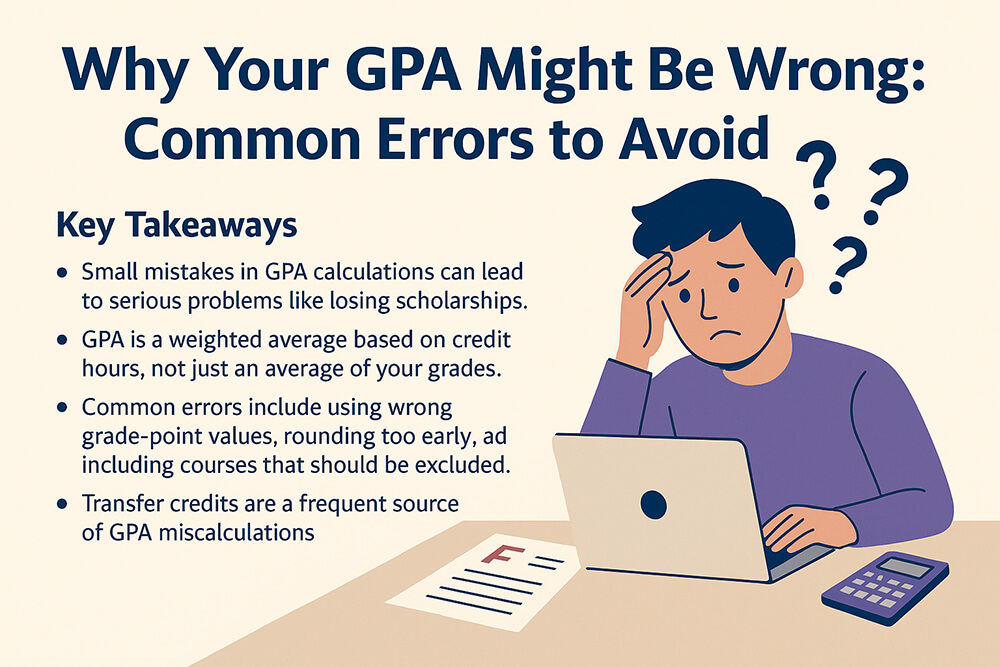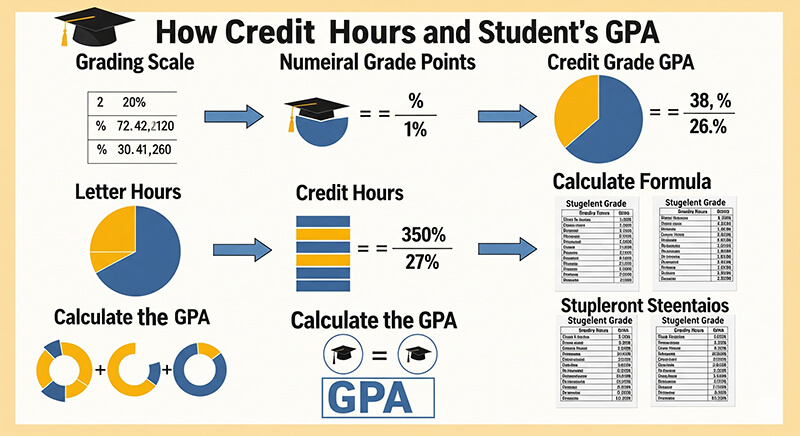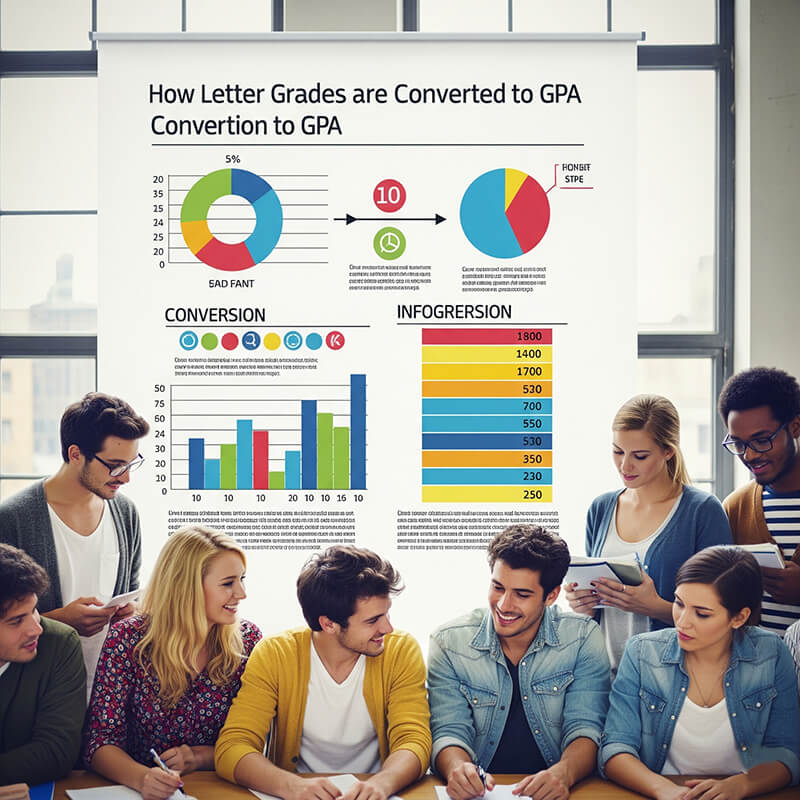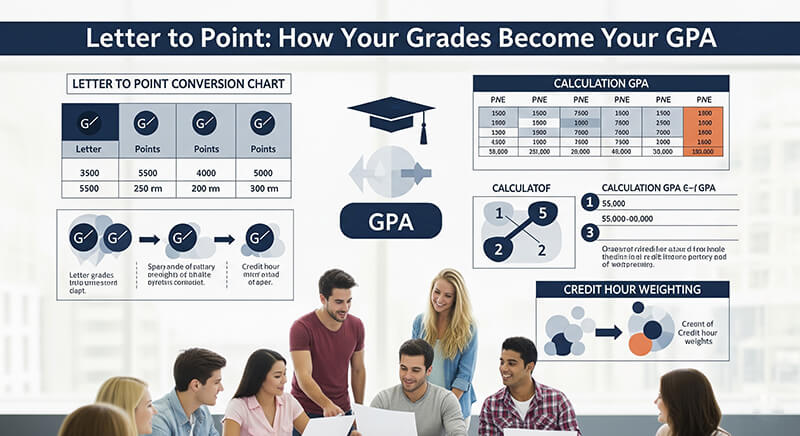Key Takeaways
- Small mistakes in GPA calculations can lead to serious problems like losing scholarships.
- GPA is a weighted average based on credit hours, not just an average of your grades.
- Common errors include using wrong grade-point values, rounding too early, and including courses that should be excluded.
- Transfer credits are a frequent source of GPA miscalculations.
- Using a reliable GPA Calculator and understanding your school's rules can prevent errors.
Why Small GPA Mistakes Are a Big Deal
Your Grade Point Average (GPA) is a very important number. It helps you get into college, win scholarships, and earn academic honors. A small mistake in how your GPA is calculated can cause big problems. Some students have lost their valedictorian title because of a simple math error. Others have missed out on scholarship money. It is important to know how GPA is calculated so you can spot any mistakes. This guide will help you understand common GPA errors and how to avoid them.
How is GPA Calculated?
Calculating your GPA is not just averaging your grades. Your GPA is a weighted average. This means that courses with more credit hours have a bigger impact on the final number. The basic formula looks at the grade points you earn for each class and the number of credits each class is worth. As an expert who has helped thousands of students, I've seen how misunderstanding this simple formula is the root of most problems.
Here is a simple table that shows how letter grades usually convert to grade points on a standard 4.0 scale.
| Letter Grade | Grade Point |
|---|---|
| A+ / A | 4.0 |
| A- | 3.7 |
| B+ | 3.3 |
| B | 3.0 |
| B- | 2.7 |
| C+ | 2.3 |
| C | 2.0 |
| C- | 1.7 |
| D+ | 1.3 |
| D | 1.0 |
| F | 0.0 |
GPA is Not Just Your Average Grade
Many students think their GPA is the average of their grades. This is not correct. The key difference is credit hour weighting. A class that is worth more credits will change your GPA more than a class with fewer credits. For example, an 'A' in a 4-credit science lab will boost your GPA more than an 'A' in a 1-credit gym class. This is why you must multiply your grade points by the credit hours for each course before you find the average.
The Wrong Grade Points for Your Letters
One of the most common errors comes from using an incorrect conversion table. Your school has a specific chart that turns your letter grades into grade points. If you use an old chart or one from a different school, your calculation will be wrong from the start. Always use the official letter to point GPA conversion guide provided by your school. I've seen students use a generic online chart, which led to them thinking their GPA was a 3.8 when it was actually a 3.65.
Rounding Numbers Too Soon
Math has rules, and one of the most important for GPA is to avoid rounding until the very end. When you calculate the grade points for each course (Grade Point × Credits), you might get a number with decimals. Do not round these numbers. Add all the exact numbers together first, and then divide by the total credit hours. Rounding each course's total points before adding them up can create a small error that changes your final GPA.
Forgetting Which Courses Count
Not every class on your transcript counts toward your GPA. Classes you take as pass/fail or that you audit are usually excluded. It is very important to know how pass/fail grades impact your GPA. If you mistakenly include these in your calculation, you could inflate or deflate your GPA. Always check your school's policy to see which courses are included in the official GPA calculation.
Computer Glitches and Simple Typos
Sometimes, the error is not your fault. The software your school uses can have bugs. A simple typo when entering your grade or credit hours can also cause a mistake. These data entry errors can be hard to find, but they can have a huge impact. One school district had an issue where a software update changed how GPAs were calculated, affecting thousands of students.
Transfer Credit Confusion
Transfer credits are a major source of GPA errors. When you take classes at another school, like a community college, those credits need to be converted to fit your current school's system. The rules for this can be confusing. Sometimes the quality points vs GPA explained system is different. One student famously lost her valedictorian spot because her dual-enrollment credits were not weighted correctly by her high school.
Student Frustration on Social Media
When these errors happen, students and parents often go online to share their frustration. You can find many stories on sites like X (formerly Twitter) where students lost honors or scholarships because of a last-minute GPA change. This shows how important it is for schools to be clear about how they calculate GPAs. As an expert in this field, I advise students to be proactive and double-check their school's work.
Use One Clear Grade-Point Table
The best way for schools to prevent errors is to have one single, official grade-point table. This table should be easy for all students and staff to find and use. When everyone uses the same numbers, there is less chance of making a mistake. This simple step can prevent a lot of confusion and frustration for students.
Check for Mistakes Automatically
Schools can use computer programs to help find GPA errors. These programs can be set up to check for impossible numbers, like a class being worth 20 credits or a grade point being higher than 4.0. Using a trusted tool like The GPA Calculator can also help you do these checks yourself. It's a smart way to catch a typo before it becomes a problem.
Write Down the Rules Clearly
Every school should have a clear document that explains all of its GPA rules. This document should list exactly which courses count and which do not. For example, it should state that withdrawn ("W") or audited ("AU") classes are not included. Having these rules written down makes it easy for everyone to be on the same page.
Tell Students About Changes
If a school is going to recalculate GPAs, it should tell students ahead of time. Students should know when the recalculation will happen and how it will be done. Sending out a notice before final grades are posted can help students prepare and avoid any surprises. Good communication builds trust between students and the school.
Let Students Check Their Own GPA
Schools should give students tools to check their own GPA. A GPA projection tool allows students to see how their grades in current classes might change their overall GPA. This helps students set goals and understand how their hard work pays off. It gives them the power to take control of their academic future. You can use a GPA Calculator to play with "what-if" scenarios.
Frequently Asked Questions (FAQs)
What is the most common GPA error? The most common error is incorrectly weighting credit hours or using the wrong grade-point conversion values for letter grades.
How can I check if my GPA is correct? You can check your GPA by using a reliable online GPA calculator and the official grade-point table from your school. Calculate it yourself and compare the result to what is on your transcript.
Do pass/fail classes affect my GPA? Typically, pass/fail classes do not affect your GPA. A "pass" grade earns you credit but does not have a grade point value. However, a "fail" can sometimes be counted as a 0.0, so you should always check your school's policy.
What's the difference between a weighted and unweighted GPA? An unweighted GPA is on a standard 4.0 scale. A weighted GPA gives extra grade points for more challenging classes, like Honors or AP courses, which can raise a GPA above a 4.0.
Can a small rounding error really change my GPA? Yes, a small rounding error, especially when applied to multiple courses over several semesters, can change your final GPA enough to affect class rank or honors eligibility.





